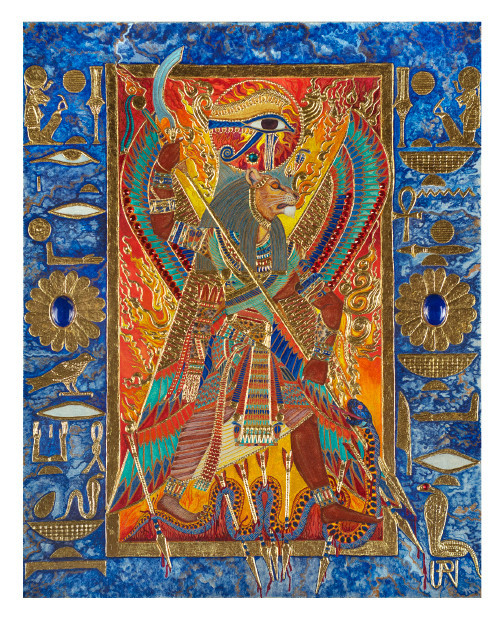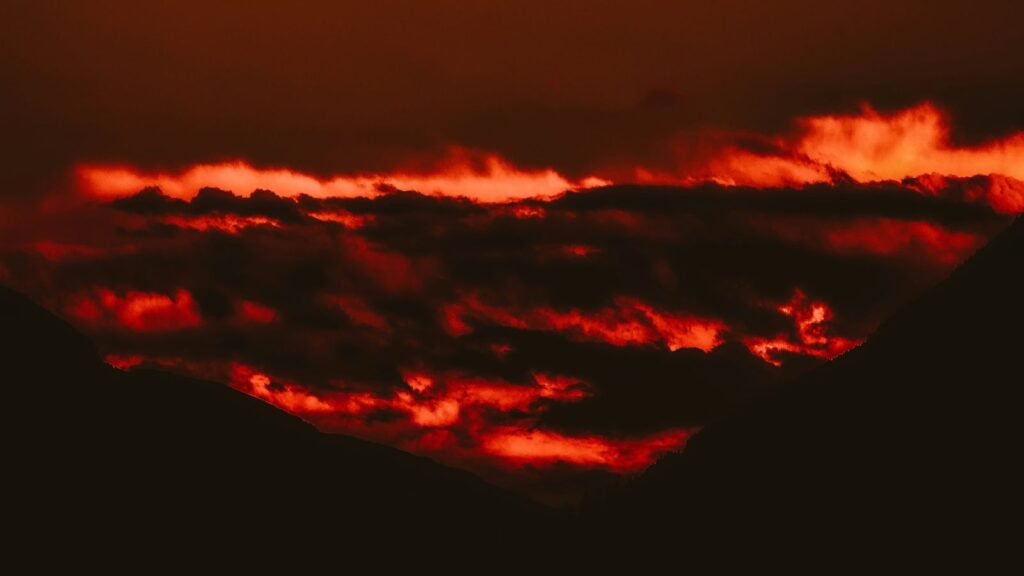Sekhmet has reawakened, her devotees say, now when the world most needs the truth and justice Sekhmet represents. In the African American community the return to Sekhmet is a homecoming. But people of all races and walks of life have responded to the call. We have no statistics as to how many devotees now exist. The most popular video on YouTube about Sekhmet has almost 700,000 views; most Sekhmet videos have views in the thousands or tens of thousands. The largest public Facebook group about Sekhmet has close to 5,000 members.
Setjataset is a healer and writer.
Randy Roark is a poet who was for many years Allen Ginsberg’s assistant. He worked in a similar capacity with William Burroughs.
ON THE AWAKENING OF SEKHMET
Deities old and new are popping up all over, from 4chan mascot Kek’s success as an election consultant to the political agenda demanded by Jehovah and Son, Inc. We’ve got white supremacists worshiping Odin and MS13 revering Santa Muerta. For some, this must look like the end times and the return of the Golden Calf, but these experiences can also be understood as a spiritual renewal. People are showing the courage to explore humanity’s religious heritage in a wider sense.
Sekhmet is perhaps the most interesting of these returns. Unlike most of the others, Sekhmet was never famous in the educated circles of the Renaissance, the Enlightenment, or any other era after her long importance in Ancient Egypt. It seems the boy’s clubs of scholarship up until this point were not comfortable with a feline goddess of justice. Her reemergence for most devotees began in 1988 with the publication of Robert Master’s book The Goddess Sekhmet: Psycho-Spiritual Exercises of the Fifth Way. But one of our interviewees, a male who wishes to remain anonymous whom we will call “1986,” first encountered Sekhmet two years earlier in a dream:
“In 1986 after being an atheist all my life I had a dream that marked the beginning of a spiritual awakening that helped me to pursue a path of devotion. I found myself in the dark chamber of a pyramid. Someone lit a small flame. With it they kindled a flat rectangular stick of what appeared to be incense, the top of which was carved into the shape of a lion’s head. I heard the word Sekhmet spoken. The dream was extremely vivid. I woke up very curious about that word. We had no search engines then so I looked in every book I had and then I looked in various libraries public and institutional. I could not find that word. After many months I picked up a relic of early Egyptology, a book by Budge, beautifully bound but long outdated, and there in the index I found Sekhmet. Seeing the line drawing of a lion headed goddess I felt an overwhelming sense of recognition and gratitude for no reason I could then fathom. I had the sense that rather than me remembering her she remembered me. I was stunned in 1988 when I walked into the Bodhi Tree bookstore in Los Angeles and found on display Robert Masters’ book with a statue of Sekhmet on the cover.”
Academia beat Masters to the punch. Philippe Germond published Sekhmet et la protection du monde in 1981, a translation of a series of invocations of Sekhmet from the temple of Horus at Edfu, including a summary and contemplation of Sekhmet’s traits. Germond focused on the dual nature of Sekhmet. On the one hand she protects the order of the universe, the good pharaoh, the honest citizen, she’s a friend to the poor and the oppressed. On the other hand she could visit pestilence and other catastrophes on people found unjust, and since no human being is completely just, everyone could be at risk. The only right way was to appease her on a yearly and daily basis. Amulets, invocations, offerings, gifts, and prayers not only show respect but also remind everyone of Ma’at, the truth about the laws of existence that underlie genuine morality, the force of balance and justice that orders the universe. Those who ignore Ma’at experience the destructive side of Sekhmet: disease, war, famine, natural disasters.
Since 1986’s dream Sekhmet has many new worshipers, new books about her, new statues, new icons, a character in Ronin Warriors a Japanese anime series, and she’s asteroid 5351. Sekhmet is a Marvel Comics character, and a Vasudan heavy bomber in Freespace 2, she also appears in the game Assassin’s Creed. You can buy Sekhmetphone cases, stickers, accent pillows and mugs. She has a temple in the Nevada desert. One of the most radical of underground rappers goes by the name of CEO Aisha Sekhmet. A death metal band from Belgium named themselves Sekhmet. Bacchus Brewing Co., a microbrewery in Brisbane Australia brewed a red beer on tap called Sekhmet‘s Rage. Then there’s Yoko Ono’s Sekhmet Productions; according to Associated Press, John Lennon bought an ancient two ton statue of Sekhmet in the 1970s.
If you wanna go all Jungian on it, Wakanda’s female warriors, the new Wonder Woman and all the other invincible super women showing up in Hollywood epics and games to fight injustice can be considered reflections of Sekhmet.
As poet Randy Roark points out, Sekhmet even allows us to redefine William Butler Yeats’ most famous and apocalyptic poem. He says:
“In Apuleius’s “The Golden Ass” (100CE), he writes about a ritual that was common during Rome’s long decline. Isis had been imported into the Roman Empire from Egypt and grafted onto Greek and Roman roots. Once a year, a ceremony was performed to renew the natural cycle, in which the thousands of masks of the Great Mother goddess were recited. The idea was that the Great Mother is hiding in plain sight all around us, all the time, unseen and unrealized in us, until we learn how to recognize her in action, in this world, behind her many disguises. When the ritual reaches the warrior goddesses Sekhmet is introduced as the natural force that burns and judges. If a culture fails to acknowledge Sekhmet it suffers unjust governments that devalue what it means to be a citizen, inequal social systems that oppress instead of protect, cultures where literacy and education are corrupted. Woe to the temporary palaces of the unjust, warns Sehkmet, when:
“…somewhere in sands of the desert
A shape with lion body and …
A gaze blank and pitiless as the sun,
Is moving its slow thighs, while all about it
Reel shadows of the indignant desert birds…
And what rough beast, its hour come round at last,
Slouches towards Bethlehem to be born?”
WB Yeats, “The Second Coming”
For Sekhmet worshipers that poem’s a pretty thrilling scenario. But who or what is Sekhmet? And who are these Sekhmet worshipers? How did they hook up with Sekhmet? Are there any obvious patterns in even our limited sampling?
To delve deeper into the world of Sekhmet devotees we asked the following questions.
- Who is Sekhmet?
- What was your first contact with Sekhmet?
- Do you worship Sekhmet solo, or with a group? Do you believe in one deity, or many?
- Do you have an altar, or an object or objects you consider sacred to Sekhmet?
- Do you have a ritual? In what ways do you communicate with Sekhmet?
- How would you describe your role as a follower of Sekhmet in the world?
- How has Sekhmet’s influence in your life changed your relationship with the world
- Where and when do you feel closest to Sekhmet?
- Are dreams an important part of your practice?
- Do you have an experience with Sekhmet as a “living statue”?
- What do you know about the connection between Sekhmet and vampires?
We also spoke to artist and Kemetic icon-maker Ptahmassu Nosfra-Uaa about the worship of Sekhmet and cultural appropriation.
WHO IS SEKHMET?
Randy Roark: “Sekhmet is primarily a war goddess. She is often represented as a lioness, which the Egyptians considered the fiercest, most merciless of the predators. She was also associated with the desert, the most unforgiving and deadly environment they knew.” Randy also reminds us: “Almost half of known cultures have a woman as their primary war deity. It is much easier to list the countries that do not have at least one goddess of war—the Aztec, Japanese, Maori, Polynesian, and Vietnamese—than those whose war deities are predominantly female—the Egyptian, of course, as well as the Greek, Celtic, Mesopotamian, Vedic (Hindu) and the Semitic. The first thing I notice in reviewing this list is that the cultures who most easily see the feminine side of warfare are those that are the predominantly literate and educated ones.”
Healer and writer Setjatset offered us this description:
“Sekhmet is the Ancient Egyptian Goddess of pestilence, health/illness, destruction, war and wisdom. Associated with sunset and retribution, she uses arrows to pierce her enemies with fire, her breath being the hot desert wind as her body takes on the glare of the midday sun. Sekhmet represents the destructive force of the sun, is depicted as a lion-headed woman with the sun disk and uraeus serpent headdress and has eyes and hair which blaze orange or red.”
In a 2006 article for NBC News entitled “Sex and Booze Figured in Egyptian Rites” science editor Alan Boyle wrote:
“Today, it sounds like a spring-break splurge on the order of “Girls Gone Wild”. Drink huge quantities of beer, get wasted, indulge in gratuitous sex and pass out — then wake up the next morning with the music blaring and your friends praying that everything will turn out all right, but back in 1470 B.C., this was the agenda for one of ancient Egypt’s most raucous rituals, the “festival of drunkenness,” which celebrated nothing less than the salvation of humanity. Archaeologists say they have found evidence amid the ruins of a temple in Luxor that the annual rite featured sex, drugs and the ancient equivalent of rock ‘n’ roll.”
Johns Hopkins University’s Betsy Bryan leader of the excavations at the Temple of Mut explained that this was a festival of Sekhmet.
The festival is said to be a reenactment of that time when Ra the Egyptian sun god grew old and humanity became evil. He sent his daughter Sekhmet to kill the unjust. Only problem was that Sekhmet saw quite correctly that all human beings are unjust, perfect justice belonging to deities, right? Today’s top killer the domestic cat capable of wiping out whole species in the nearby landscape reflects Sekhmet’s playfully lethal force as she came close to erasing Ra’s humanity mistake. How to stop her? Give her red beer, it looks like blood. Sekhmet gets drunk and amorous. There’s also the story of how her husband Ptah sometimes gets depressed being a creator god so she reminds him what makes life great by flashing him. Call back to that festival in Egypt?
Sekhmet is 1/3 of the Memphis triad, perhaps the loveliest divine trinity in history with her creative husband Ptah and their son Nefertem the blue lotus also known as “He Who is Beautiful” and “Water-Lily of the Sun.” But Sekhmet has a life of her own aside from her divine duties and her family. She enjoys walking out in the desert on really hot days in the body of a large lioness.
No one knows the origin of this deity, though she is among the earliest in our gallery of goddesses and gods. Perhaps she began as a totem spirit for a female warrior society in Nubia, Sudan, or Libya. What does the name Sekhmet mean? In the simplest English possible it means Power.
So let’s review. There was this Goddess in ancient Egypt whose name is Power. Huge festivals of music, intoxication, sex, and prayer were celebrated in her name. The ultimate killer but also the ultimate protector and healer. Absolutely devoted to justice. The most powerful warrior, both feline and female. Folks, seriously, Kek can go fuck himself. Forget the rest, stick with the best. (We do note that the actual ancient Egyptian Kek is a cutie).
FIRST CONTACT
How do devotees generally come in contact with Sekhmet for the first time?
One of our interviewees, a female who wishes to remain anonymous that we’ll call “AntiKek,” found Sekhmet when seeking a response to the Kek phenomenon:
AntiKek: “I was researching memetic warfare and magical warfare, and ran across some folks who were using magic and Kek to get Trump elected. I was looking for something magical that counters both Kek and Trump, and Sekhmet seemed like the right deity. So I picked up a book on her, and somewhere in the middle of a chapter, I stopped reading, started meditating without actually doing it consciously, and felt her presence. She licked my face, and purred.”
Dr. Thea Wirsching of the American Renaissance Tarot project first met Sekhmet in a museum.
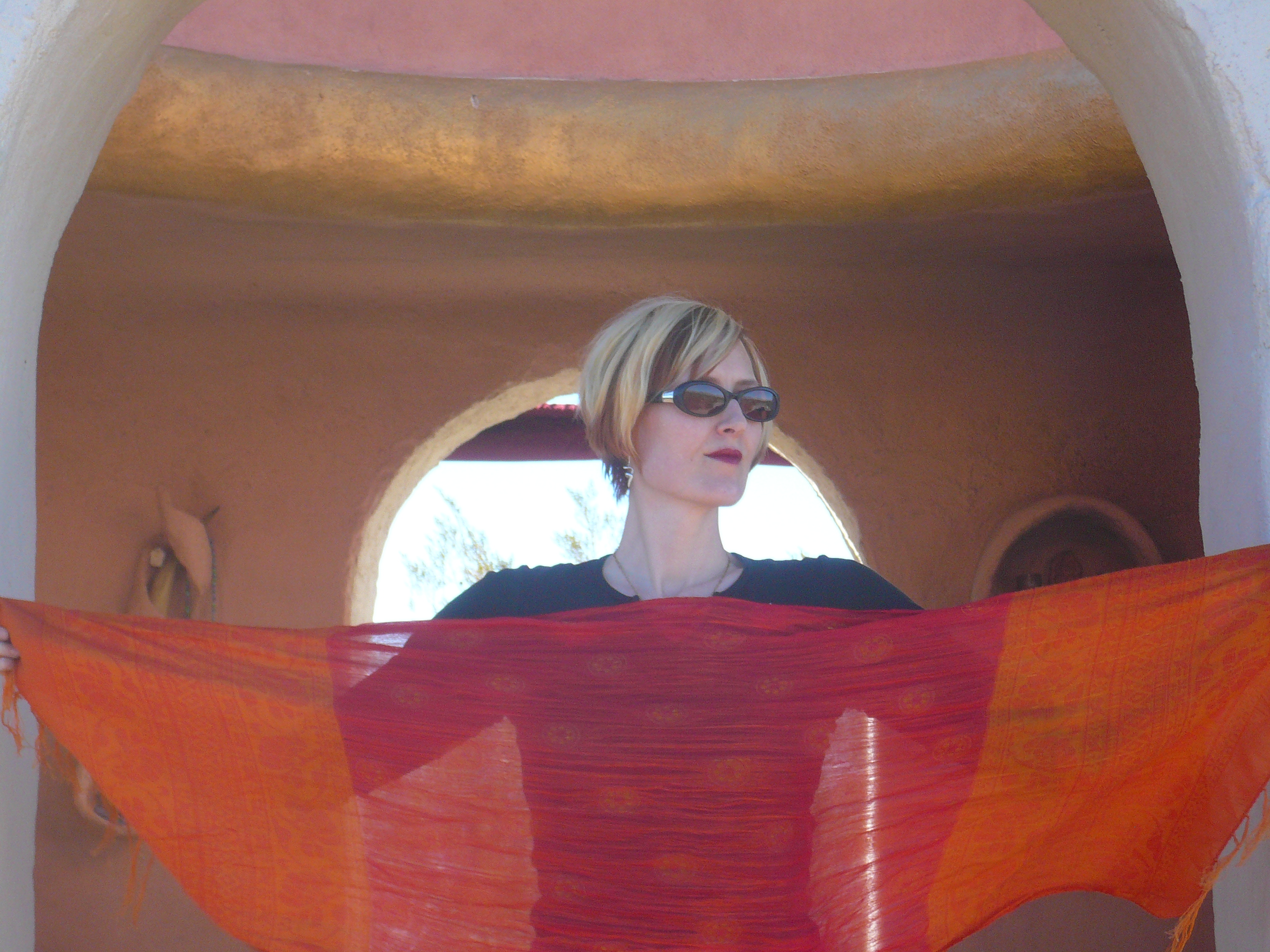
Thea Wirsching: “When I was 27 I was living in Munich and doing a German language-education summer program. I visited the small Egyptology museum in Munich and was brought to my knees by a living statue of Sekhmet. It was difficult for me to understand what was happening. I already identified as pagan but felt self-conscious about my dramatic response to the seated statue. A German family was in the exhibition hall with me, touring the museum, but I couldn’t stop myself from kneeling before Sekhmet and holding my arms up to her in worship. I stayed with her for almost an hour. It was incredibly emotional – I was just overcome with awe and cosmic love. I’d never heard of Sekhmet before and remember taking note of her name on the museum wall placard because it was such a strange experience.”
For dancer and former priestess Ginette Novello, her first encounter with Sekhmet also involved a statue in a museum.
Ginette Novello: “She first communicated with me through a beautiful rose granite statue of Her at the Field Museum in Chicago. She demanded that I pay homage to Her by kneeling before Her statue. The “pull” to do this was very strong! I did as She asked, of course, even though I was a bit embarrassed to do so in front of all the other visitors to the museum who gave me some strange looks. I later discovered that this particular statue of Sekhmetwas apparently an object of veneration by others, with flower garlands and other offerings “mysteriously” appearing from time to time.
“Less than a year later Sekhmet was officially divined as my spiritual Mother in my religion of Kemetic Orthodoxy. In spite of my previous experience at the Field Museum, I was very surprised. I thought the result of this divination would be Her other aspect of Het-hert (Hathor) since I’ve always been involved with music and dance. However, in looking back I can see how I’ve always associated with Sekhmet’s traits: I’m very blunt and don’t play games, and I have an inner core of strength that has gotten me through a lot of difficult times.”
For an anonymous interviewee I’ll call “Amber,” a statue also played a role in her first experience – this time, in a dream instead of a museum.
Amber: “I first observed a dear friend have their own experience with Sekhmet. I was very impressed with the whole concept of the lion headed goddess. Aside from an affection for stories about the gods and goddesses of the ancient Greeks, I had an aversion to deities of any kind and to all religion. Then I had that dream. A dark hallway lit by two torches. Stone all around me. Kinda creepy. I entered a chamber. About twenty feet in front of me a thirty foot black granite statue of Sekhmet lit by torches each side. I hear her in my head as I stare up at her: “Wear amber for success in any battle.” One of those dreams that feels more real than real life.”
Setjataset’s introduction to Sekhmet emphasized the healing power of the deity.
Setjataset: “Sekhmet first called me when I undertook studies in Natural Medicine back in the early 00’s. Over the years she has played a significant role in my life through the healing arts. Despite the feared reputation she is known for, I personally found I never approached her with trepidation but instead with awe and respect. In turn I found she bestowed many blessings on my magickal and healing path.
“I started off solitary but within a family environment. My mother was a magickal practitioner and was the one who taught and infused my life with Hermetic and Greek Folk Magick and was in turn taught by her aunt who studied in Alexandria under a Magus.”
Some found Sekhmet, or she found them, after already having experiences with the worship of other Gods. Interviewee Fanny Fae also known as NiankhSekhmet, which means My Life is Sekhmet‘s, clergy emeritus of the House of Netjer, a Kemetic Orthodox temple, was surprised to find herself on Team Sekhmet
Fanny Fae: “For years, I thought I belonged to Aset and then one day Sekhmet appeared in my life and said, ‘MINE!’ She scared the crap out of me because I remember a well-meaning Wiccan friend saying, “Oh, don’t mess with Sekhmet! She can really hurt you!” She kept insinuating Herself in my life. Books falling in my path at the local metaphysical store, images popping up and me becoming obsessed enough to get a passport and get on a plane and cross the Atlantic to go to the British Museum so that I could present myself to Her. I have been in love and in awe of Her ever since.”
Omma, proprietress of a lovely shop in Memphis with the witty name The Broom Closet, had a similar encounter:
Omma: “My initial experience with Sekhmet was unexpected. Years ago I was taking a Goddess class through a local Wiccan church. The object of the class was to meet and work with one Goddess for the duration of the class (one year). In meditations I kept having interactions with Bast, and so I assumed that Bast would be the Goddess I would work. At one of the initial class meetings, we went on a journey to the “Goddess’s Garden” where we were to meet the Goddess we would spend the next year with. The Goddess who showed up was not Bast, it was Sekhmet.
“Sekhmet was not an energy I wanted to work with. Her intensity and what I knew of her mythology scared me. I was very much taken aback by her presence. However, she immediately “claimed” me and has not left me since that day, even when I was unsure if I wanted her around. But I very much needed Sekhmet’s energy at that point in my life and I believe she has been a big help in getting me to where I am today.”
Like Omma, Gus Pinto’s experience began with Sekhmet‘s sister the black cat headed original domestic goddess Bast:
Gus Pinto: “I was drawn to Sekhmet through Bast – it was as if there was this family of feline goddesses (and their brother, Maahes), who were all protectors, and I wanted to be a part of that family. In Bast, I had found license to take pleasure in dance and music; in my late thirties – and much to my surprise – I discovered I had a wild side that pushed the limits of what I thought might be acceptable: Sekhmetallowed me to channel that unexpected wildness into something more than risqué behaviour.”
Chelle Fraser’s initiation occurred without need of dreams or statues:
Chelle Fraser: “My initial experience with Sekhmet was in conversation with a friend who brought up that I reminded him of her, so I started doing a little research and found out more about her. I then realized that I really felt connected to her. She is so passionate about everything – there’s no middle for her. If she loves you it’s fiercely, and if she hates you, you’re probably not gonna survive.”
For an anonymous interviewee I call “Australia,” it was a book that revealed Sekhmet:
Australia: “My initial experiences with her, I didn’t know it was her until I was in Australia. While I was on that trip, she identified herself while I was reading the book ‘Magic in Ancient Egypt’ by Geraldine Pinch. There was a full page pic of a statue of her from the Temple of Mut. When I landed on that page, she said, ‘That’s me.’ She was often in my dreams, and for a long time, present as ‘thoughts from somewhere else’.”
“We’re not talking about religion here, in which our priesthoods and scriptures demand worship and deference to some monotheistic father figure in the sky. That’s a belief system, and an archaic one at that. We’re talking about authentic transpersonal experience of the subtle and causal worlds, in which we can come into relationship with forces that are real. But how those forces are experienced depends on how we, as individuals, are psychologically focused.”
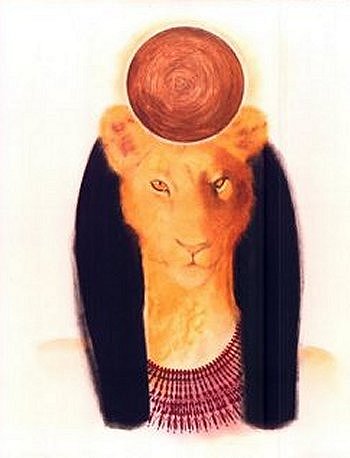
SOLO OR GROUP? ONE DEITY OR MANY?
Of our twelve interviewees, seven have been and are solo practitioners, the other five belong or belonged to formal groups. Some are solo by choice, but more are solo because there is no group to join in their area.
Amber is solo by choice: “I’m not part of any formal tradition. I don’t feel comfortable worshiping alongside others.”
Fannie Fae found a way to create a Sekhmet community online
Fannie Fae: “Solitary work is a constant I think for all of Sekhmet’s kids. In addition, however, I was formally initiated into the House of Netjer Kemetic Orthodox Temple in August of 1998 as Hm-t Netjer Sekhmet-Mut / HetHert. I retired from formal temple service a couple of years ago in order to go to school and to finish my book “Sekhmet: The Beauty and the Terror”. My intention was for the book to have a more scholarly and traditional presentation rather than an anthology or something that was UPG (unverifiable personal gnosis).”
Thea Wirsching is an example of how solo and group approaches can compliment each together.
Thea Wirsching: “One day when I was jogging in the noon heat in Southern California, I heard the words, “You are a Priestess of Sekhmet.” I didn’t know what that meant or how to make that a reality. Ultimately I discovered the Isis Oasis via a Bast Priestess who was very active on social media. I drove out to their yearly convocation in 2010 with the conviction that I was a Priestess of Sekhmet, but without having made any contact with the Temple beforehand. A Priestess I had traveled to Egypt with in 2007 recognized me and agreed to sponsor my last-minute ordination. I had the honor of being ordained by Lady Olivia Robertson when she was 93 years old. I was formally initiated as a Priestess of Sekhmet, Bast, and Hathor in the Temple of Isis and Fellowship of Isis on 10/10/10.”
Thea Wirsching: “I have served other deities before but Sekhmet has made it clear to me that she is primary. I can appeal to other deities but with the understanding that those relationships occur with Sekhmet‘s grace and permission.”
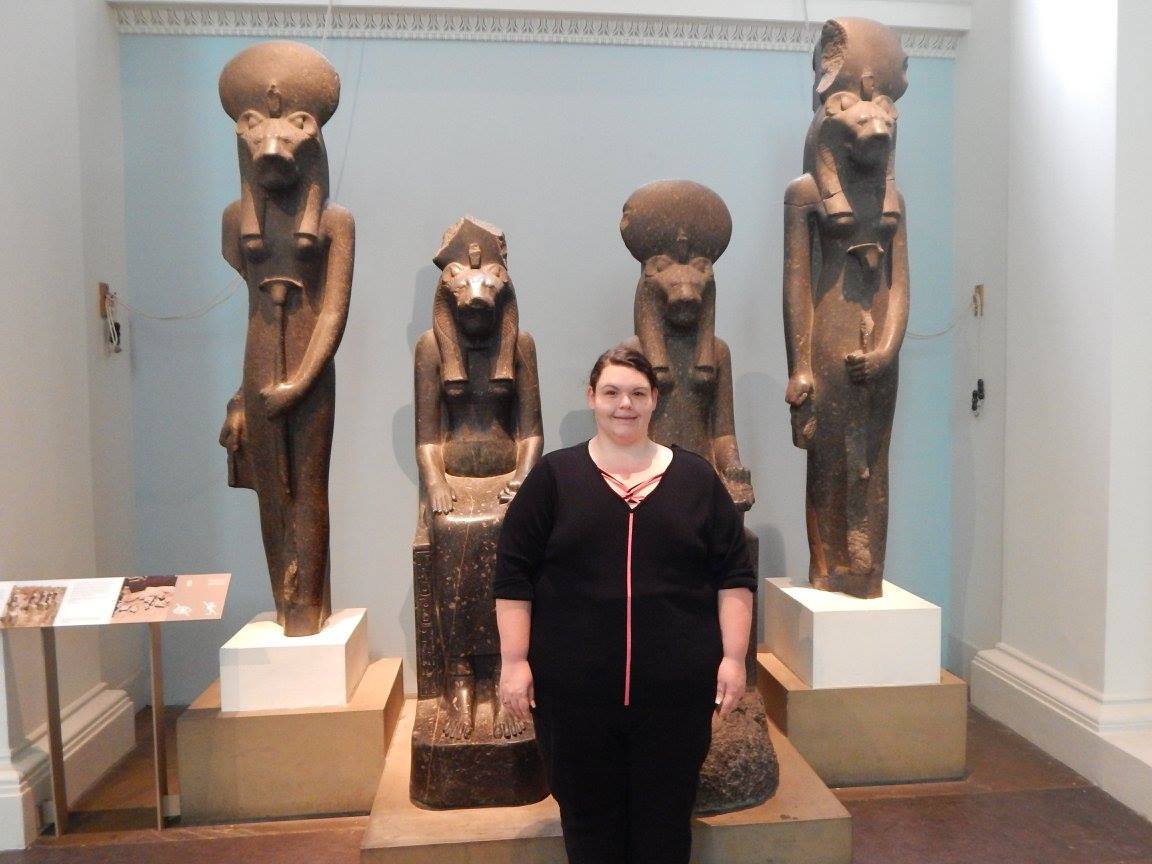
Omma: “I am a polytheist and I serve and work with various deities from different traditions and cultures. Sekhmet is my Matron Goddess, she is closest to my heart and the one that I depend on the most. But I do worship many other gods.”
Gus Pinto is an example of the strictly Egyptian approach: “I try to serve Ma’at primarily, by serving Ma’at (and my 30+ crew of cats), I figure I serve all of Netjer. Still, Sekhmet. Tefnut, Mut, Menhyt, Pakhet, Maahes, Mafdet and Bast are all close to my heart, as is Lady Nebt-Het and Her connection to the afterlife. Aset, Khonsu and other aspects of Netjer sometimes touch my life too.”
1986, while “respectful of all forms of divinity as presented in differing times and places,” practices something closer to monotheism.
1986: “When I read Ptolemaic invocations to Sekhmet the declarations of Ra’s pre-eminence seem like interpolations. I’m not saying they are. They just feel that way to me. I feel that if we unmasked every deity we would ultimately find Sekhmet at the center of all.”
ALTARS AND SACRED OBJECTS
What kinds of altars or sacred objects to devotees associate with Sekhmet?
All of our interviewees had some kind of sacred object associated with Sekhmet in their homes, like a statue or photo. Below are some of the more involved altars.
Thea Wirsching: “The ankh, crown, gown, and mantle blessed at my ordination are all sacred to me. I also have a Ptolemaic-era pendant of Sekhmet that I wear occasionally. I own several Sekhmet statues and I cherish a heart-shaped piece of pink granite I found outside Sekhmet‘s Temple in Nevada.”
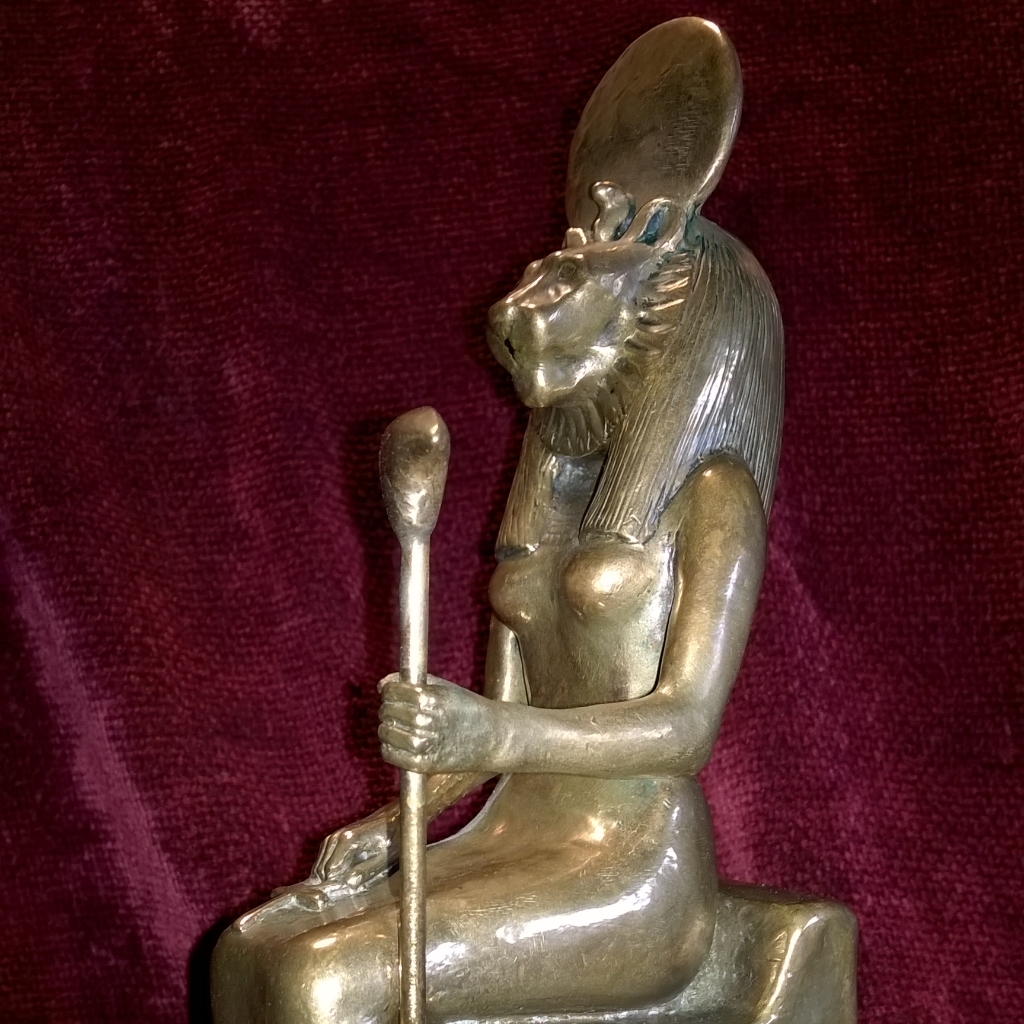
Fannie Fae: “I have a personal shrine that is more informal than the state or naos shrine. Because I was extremely dissatisfied with the configuration and quality of the statuary representing Sekhmet that was available, I commissioned one of our Temple members, Jennifer Gray (SahYinepu), to make one of Her from bronze. It took me a bit to save up for it and it was absolutely worth it. I have other items that people have given to me such as the painting of Sekhmet that was done for me by Jeffrey Spencer (Asetreshetef) as an ordination gift. This painting is in the main room of our home and the eyes look straight at you no matter where you are at in relation to it. Sekhmet’s eyes are always watching at all times!”
Randy Roark’s detailed response gives us a glimpse into an organically grown polytheistic practice.
Randy Roark: “Over many years, I have grown a shrine in my kitchen, as I meet and come to recognize various gods and goddesses appearing in my life. It is structured on several levels, beginning at the level of my hips. This is the ground; home, the front door, snakes, feathers, beeswax, beehives, the Melissae, amphibians, money, alabaster, incense. Above it—at the level of my heart—are the male gods I’ve recognized in me—Shiva, Dionysus, Apollo, Krishna, The Sacred Heart of Jesus, the poets, musical instruments, typewriter, the leopard, the hand, handicrafts. Above it the female, at the level of my forehead or intelligence and insight and intuition. More about this level later.
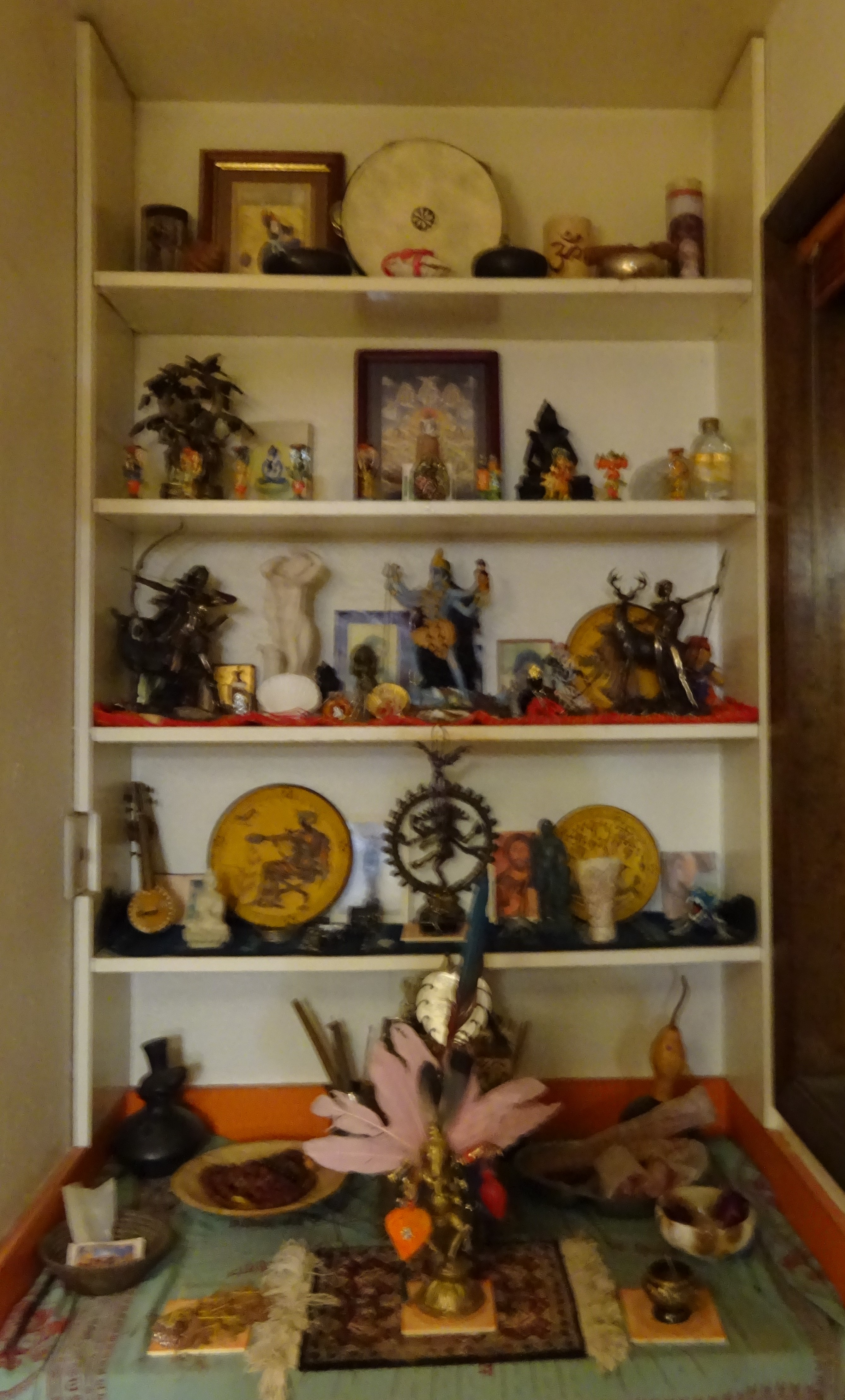
Gus Pinto: “Currently, I have my Bast statuette comfortably ensconced in a spot in the enclosed garden I created for my senior cats to get a break from the youngsters’ rowdiness. I do light incense for Her and burn candles from time to time, but don’t see the area as a focus for worship. For me, bringing the mind into the present and then going into internal ritual is the better fit. When dance becomes a form of worship, a nightclub can – with the right intention, dedication and focus – be transformed into a temple, even if only for one of the dancers. You are the altar, you are the offering, your heart and focus are the “sacred objects”.
RITUAL AND COMMUNICATION
What rituals do devotees associate with Sekhmet, and what ways do they communicate with Sekhmet?
Thea Wirsching: “I make a weekly SUNday offering to Sekhmet with solar incense, flowers, and food offerings. Sekhmet appeared to me on the Leo New Moon in 2008 and showed me that she is an embodied goddess. She taught me how to feel her presence physically by breathing into my heart chakra. My ritual and communication with Sekhmet involves allowing my own internal energy to match her divine majesty. In communication with her, I become goddess in my human body. Sekhmet enters my body as self-love, divine consciousness, and absolute sovereignty. This ritual is extremely centering and I have used it to heal both physical and emotional ailments. Working with Sekhmet has allowed me to overcome childhood sexual abuse and PTSD by eradicating my internalized shame.”
Fannie Fae: “I perform daily rites in my personal shrine and do what is called “state rites” or the “Rite of the House of the Morning” which is done for the community/Temple/world as a whole. My magical work and furthering my education in that area is always in service to Sekhmet.”
Amber: “Direct communication. Sekhmet is always there. I don’t need ritual to communicate with her. No disrespect to ritualists, they are beautiful. I speak to a stepped down representation of Sekhmet, the spirit I walk with in daily life while I’m down here. She communicates in various ways. Sometimes very directly, like telepathy. But also with animal messages.”
Chelle Fraser also mentioned animals as messengers: “I usually do morning and evening rites for my Egyptian shrines. I also do healing prayers and rituals at others’ requests at her shrine. I spend time doing journey work with her or meditating on what she is saying. Sometimes she sends messages in other ways, like little found objects or animal messengers.”
Setjataset: “I attend her shrine daily. I leave offerings in the forms of water, incense and hymns. On special occasions like her feast days I leave bread, beer, pomegranates and cooked meals specially prepared. Some rituals are elaborately researched written and performed whilst other times they just come from the heart in an ad lib kind of way.”
Gus Pinto: “Dance is primary – music is nice to have, but not necessary (inner rhythm will do), and preferably where there is space to move around a bit. Once the mind allows itself to be untethered from the senses, then direct conversation is possible. At other times, when I’m quiet, She will comment on something I’ve been thinking about, if She deems it necessary.”
Australia: “Most of my communication with Sekhmet is prayer, in the moment. However, I do make offerings to her from time to time. The offering prayers I use are from Richard Reidy’s book ‘Eternal Egypt’. Sometimes I change up the words a little to be more relevant to what I’m doing. But basically, I use offering prayers for water, incense, libations, food, and flame found in his book.”
1986 responded: “My ritual is attentiveness to Sekhmet, to continually realize. Waking, falling asleep and orgasm are important moments of recognition.”
ROLES IN THE WORLD
How do these devotees describe their role as a follower of Sekhmet in the world?
Thea Wirsching: “I think I am always in the process of discovering that, but one thing that being Sekhmet‘s Priestess means to me is Right Relationship to Power. Personally, I have sustained so much abuse at the hands of patriarchy, and yet Sekhmet has been my guide in matching violence and abuse of power with fierce compassion. I serve her by walking in majesty, authority, and sovereignty, but without resorting to violence or claiming power over. In my astrology practice, ‘The Pluto Babe,’ I cultivate a clientele who have endured severe trauma. I feel that I am doing Sekhmet‘s work by facing the reality of violence squarely, in terms of the damage it has done to my clients, and by serving as an example that people who carry Plutonian feelings (rage, depression) can be “spiritual” too. Sekhmet has been my awakener in the idea that fierceness and anger have a sacred quality and do not necessarily need to be transcended or “healed.” Anger is a gift, and we do not have to use it to wantonly destroy ourselves. Rather, we can direct anger toward its sacred purpose of creating social, political, and collective change.”
1986: “Wherever I find indications of Sekhmet I do my best to help that person or project achieve success. My own creativity is devoted to honesty, justice, and empowerment of women. I pay attention to Ma’at daily.”
Omma: “I think whether we have a platform to do so or not, everyone who is a follower of paganism has the role of helping bring the gods back into the light and back into mainstream culture. Each of us doing our own little work, in our own little patch of Earth is helping weave a tapestry of change. I have a slightly larger platform than others with my store and church. So I feel like one of my roles is to help educate others about Sekhmet and paganism in general. Speaking at a personal level, my role is to learn, transform and grow.”
Ginette Novello: “To help and uplift others, especially the less fortunate. To stand up for Truth and Justice in a world where money and power would corrupt and oppress. To help bring about the change that my license plate on my car proclaims: “Ma’at Now!”
Fannie Fae had a simple but profound response: “My role is as She determines.”
Chelle Fraser: “I am a priestess of her, and I try my best to do what she asks of me. She is a great healer, so I do a lot of healing for others. As her priest I am always on call. I try to live by example and stand up for justice. She also seems to require me to do quite a lot of exorcism work for others as well.”
Gus Pinto: “To heal, to stand up against isfet (chaos), to simply be an anchor for Ma’at wherever you may be. To work towards mastery over the ego and its urges; to seek not revenge, but redress (learning from Sekhmet’s own experience when She was sent to earth to punish and correct the behaviour of the people and lost control of Herself).”
Australia: “Sekhmet has made my role very clear. I’m a counselor. I especially feel called to work with prisoners and parolees. Sekhmet has taught me that people deserve a second chance. She doesn’t like waste. So that is the work I dedicate to her, and feel she oversees.”
Amber: “My job is demonstrating fearlessness, to be an example to people who are afraid, which is the scariest thing that could have been presented to me and my psychology. As a lifelong sufferer of PTSD this was difficult, but as of now I’ve confronted bullies many times in public. In those scary situations I knew I was put there by Sekhmet and I had to do the Sekhmet thing.”
Setjataset: “To me a connection and devotion to deity as well as nature is a gateway to higher forms of magick and spirituality, which not only transcends the physical but lives within it and with Sekhmet the focus is healing – healing the self and assisting with the self-healing in others. As I have grown and developed as her devotee new modalities of healing have opened up to me. At the time Sekhmet came to me I had just started studying alternative therapies and one of my personal focuses is Ancient Egyptian Medicine where Sekhmet and her healing priests are a dominant force. After this came Sekhmet Sekhem a vibrational healing modality which I became a master of and currently teach. So I describe my role as a follower of Sekhmet as a healer and facilitator of healing just like the priests of Sekhmet in Ancient Egypt.
CHANGED LIVES
How has Sekhmet changed the lives of devotees? How has their relationship with the world changed?
Amber had a succinct yet poignant response: “Instead of being a fearful shadow on the planet I’m a fearless defender. I still feel fear but I confront it because I know I am in the right place at the right time and I have the ultimate back up.”
Thea Wirsching: “Through working with Sekhmet I understand that I am both human and divine. I no longer have the luxury of imagining that I am a limited human being living in a strictly material universe since encountering Sekhmet.”
Australia: “Sekhmet has definitely changed and influences my relationship with the world. I am a little misanthropic, naturally. She made it clear that serving her meant serving my fellow humans. My motivation to serve her is strong because she has done so much for me. I want to “pay it forward” so to speak. I don’t have to tell people about Sekhmet to do that, just do the work she has set forth for me. It was very scary work for me at first, because I’m actually really socially anxious. But it turned out to be more rewarding than anything I could have imagined for myself. I’m grateful for the work she gives me. It’s a privilefge.”
Gus Pinto: “For me, Sekhmet inspires me to (re)claim my power and to stand my ground – not as a path of aggression, but as a deeper knowing of my own strength and resilience.”
Chelle Fraser: “Sekmet gave me the strength to stop people pleasing and stand up for what I know to be right for me, which was very hard for me to do. I have a hard time disappointing or upsetting others and she made it very clear to me that I must respect myself or she would make me very uncomfortable. I have learned to evaluate every situation and hold myself to my own truths because of her.”

Omma: “When I first met Sekhmet, her presence in my life opened me up to a community of people who worshiped Ancient Egyptian deities. It was nice in the beginning to have others who, although they did not necessarily work with Sekhmet, understood my love and fascination with all things Egyptian. Since having Sekhmet in my life, I have changed and that influences how I interact with the world. When Sekhmet first came to me, I needed courage and a backbone. I needed some tough love. Sekhmet worked on me and with me, helping me feel more comfortable with myself, more courageous and more confident. I was always an introvert who was self-conscious and wanted to stay in the background. I never imaged that I would go from being shy and nervous to High Priestess of a church, owning a business, being seen as a leader in our community, standing up in front of people teaching, or giving interviews. Long story short, Sekhmet changed my entire world and life and I couldn’t be happier.”
1986: “Sekhmet allows me to experience devotion to divinity. As I look back on my life I see how many times my life was saved by a person, animal or other event that in retrospect I see reflect Sekhmet, and so I feel Sekhmet has been guiding and protecting me all my life. As a person who suffered abuse as a child at home and at school this protective presence has been entirely transformational. Sekhmet has taught me to love and enjoy life, and she has showed me ways to help others without harming them or myself.”
Setjataset: “As healer and writer it has made my relationship with her more public. I now write and teach about Sekhmet and it also gave me a unique opportunity, in 2015 I was fortunate enough to edit my first book on Sekhmet which I proposed to Bibliotheca Alexandrina (a small non profit publishing house which publishes anthologies featuring contemporary Hellenic and Kemetic polytheist authors in honour of the Gods). I also personally contributed to this anthology and its called Sekhmet Daughter of the Sun: A Devotional Anthology in Honor of Sekhmet.”
FEELING THE PRESENCE
Where and when do the devotees of Sekhmet feel closest to the deity?
Ginette Novello: “Usually in my morning devotions in front of my shrine, and in any service that helps women and children. Unlike some of Her devotees who serve her in various paths of healing and protection services, She seems to prefer me in teaching positions that help or otherwise educate others. I presume She sees and utilizes our talents accordingly, as I don’t lay claim to any healing or martial abilities! But as a high school and adult education teacher (now retired), I’ve received feedback from my former students who have told me that I’ve had a positive impact on their lives. These are my offerings to Sekhmet, and I shall seek to continue them however I can.”
Fannie Fae: “There is never a time that She is not present in my life. Either I see her pictures, images around me in my home or whenever I do herbal work or ministry to the world at large. That’s part of being a Priest/ess. You are made continuously aware of the vows that you take and your responsibility in service of Sekhmet and ultimately Ma’at. Forgetting that or getting out of that is not an option.”
AntiKek: “When I meditate.”
Chelle Fraser: “When I am doing ritual for her, singing her praise hymns and taking care of my shrines, or sometimes at bonfires.”
Gus Pinto: “At night, under the moon and stars, and when I dance.”
Australia: “I feel closest to Sekhmet in the morning when the sun has just risen. When I am awake at that time, I direct my thoughts, love, and petitions toward the sun. She never lets me down.”
Amber: “Cats, libraries, fire, music, love, intoxication, passion, courage, honesty, strength all make me feel close to Sekhmet; I feel that constant companionship weaving through my life.”
1986: “Sekhmet is always with us, but the orange light of early dawn, or sitting in the sun on a hot day, I feel as if the very warmth of the sun and wind are Sekhmet‘s breath, and the sun the glint of Sekhmet‘s eye.”
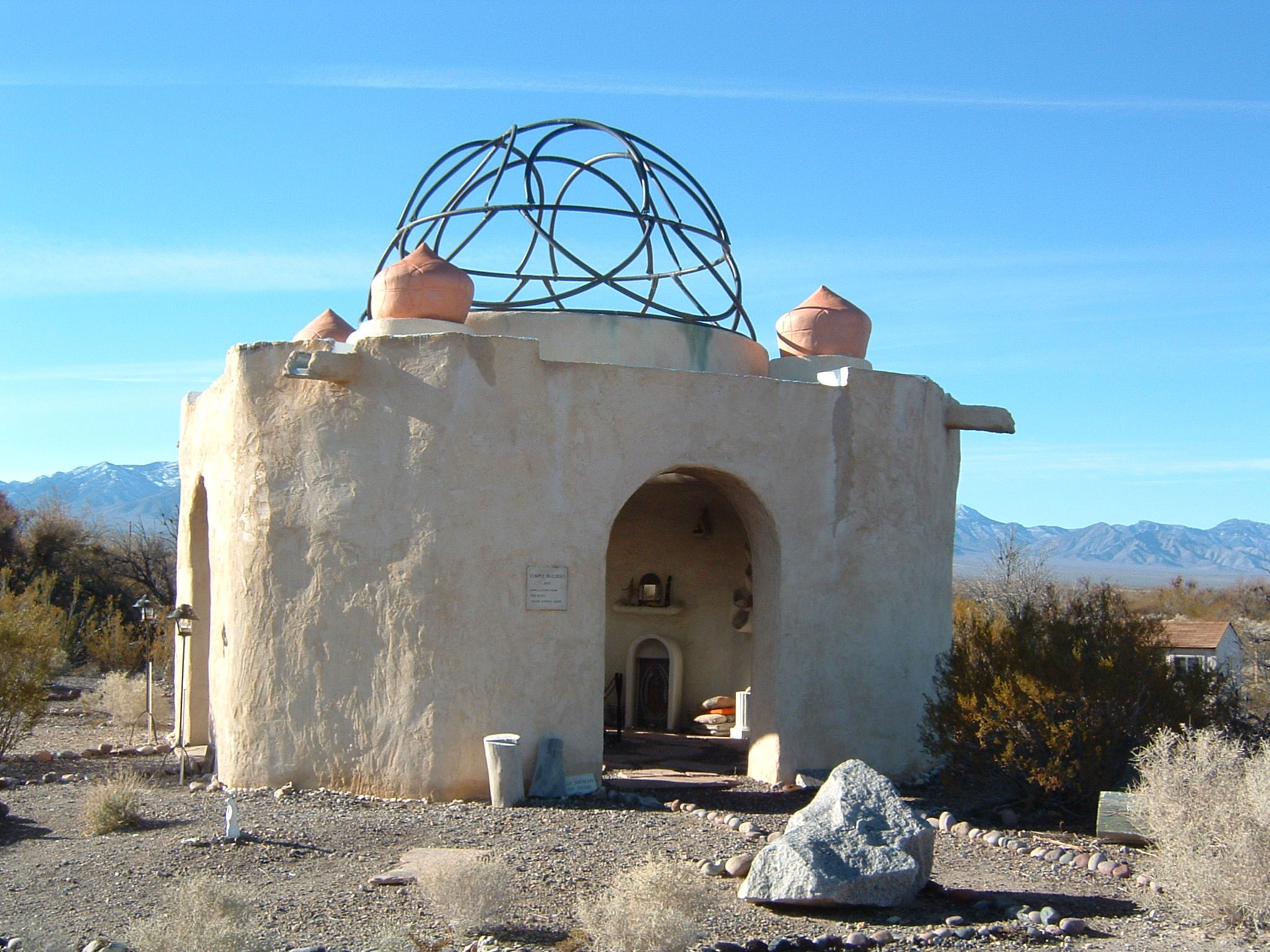
SEKHMET IN DREAMS
Are dreams an important part of the practice of devotees? For most of our limited and very unscientific sampling the answer is yes, but dreams of Sekhmet hold less importance for others.
Thea Wirsching: “The most powerful one involved me feeling myself as Sekhmet‘s statue. I was aware of my stone arms and legs and the feeling of being buried under rocks. Then I felt myself being propelled out of the rubble and ascending higher and higher. Ultimately I emerged outside the Great Pyramid at Giza under a Full Moon. What I heard in my dream was, “I am emerging into light after a dormancy of 4,000 years.” I remained a conscious seated statue in the dream even after being liberated from the ground.”
Ginette Novello: “She has answered my calls for help in dreams when I’ve been in adversarial situations.”
Fanny Fae: “When I first encountered Sekhmet I began dreaming about lions. I had when I was smaller, but I had no idea what it meant. About the time I hit my Saturn Return was when she showed up in dreams again. When I was a kid we used to go to the St. Louis Zoo quite a bit and there was a big building called the Lion House. In the dream I was there inside this place in a room that was not a cage, but made of stone. I was naked and being being bathed by a woman who was wearing a kind of metal veil across her face, and she was weeping. In the mirror behind me, on a slightly raised platform, I saw a very large lioness watching. I am sure that it was Sekhmet. This was about three or four years before my Initiation. She kept appearing in my dreams and still does.”
Chelle Fraser: “Yes many times. The first time it was to rearrange some things internally for myself. The most recent one I was going to a ritual for her but others showed up wearing some cheap Halloween costumes, and I was wearing my priest gown and crown and such, and everyone was noticing and she was smiling at me.”
AntiKek: “Just once. I didn’t *see* her, just heard her voice.”
So far, dreams have not been a part of Omma’s Sekhmet journey.
Gus Pinto responded with a profound approach to dream interpretation.
Gus Pinto: “Yes, but I think that what we see in dreams is not necessarily meant to be exactly what we see: I once dreamed that one of my most-loved cats was caught in a whirlpool and woke up realising that my sister was feeling overwhelmed and desperately needed someone to talk to. After that, I began to work through what I had seen in dreams, trying to link the symbols and actors my subconscious chose to waking-world events and people.”
Australia: “Sekhmet has been in so many of my dreams. Too many to count. I would say my strongest memories are of the earliest. She would appear in so much light it was hard to see, and coming down bright steps that seemed like gold reflecting the sun.”
LIVING STATUES
Living statues were a big part of ancient Egyptian religion. With proper ritual, a statue can be opened and the deity can dwell there. Living statues are said to have numinous powers of communication. The Neoplatonist Iamblichus in his On the Mysteries draws parallels between living statues and enlightened sages, both enshrine the divine. Hank Wesselman provided an extensive description of his own experience with a Living Statue posted last year by Reality Sandwich here. Have our devotees experienced this mystery?
Setjataset: “Yes with my personal statue various times over the years when in shrine or when conducting sekhem intunements and healings. Also many years ago there was an exhibition of Ancient Egyptian artefacts where a large black basalt statue of Sekhmet from Luxor was on display and I had an intense experience with two of her other devotees who were also there at the same time.”
Amber’s initial encounter with Sekhmet was in a dream about a living statue. What makes this especially interesting is that Amber had never heard of the concept of living statues before that dream.
Australia: “Yes. I was a W’ab. We maintain open statues.” W’abs are priestesses and priestesses who have achieved a level of purity that gives them the privilege of attending the inner sanctum.
Gus Pinto: “Not yet, but I look forward to the day.” AntiKek had a similar response: “No, but I’d like to go to the one by Karnak, for sure. I’ve heard a lot about others’ experiences.”
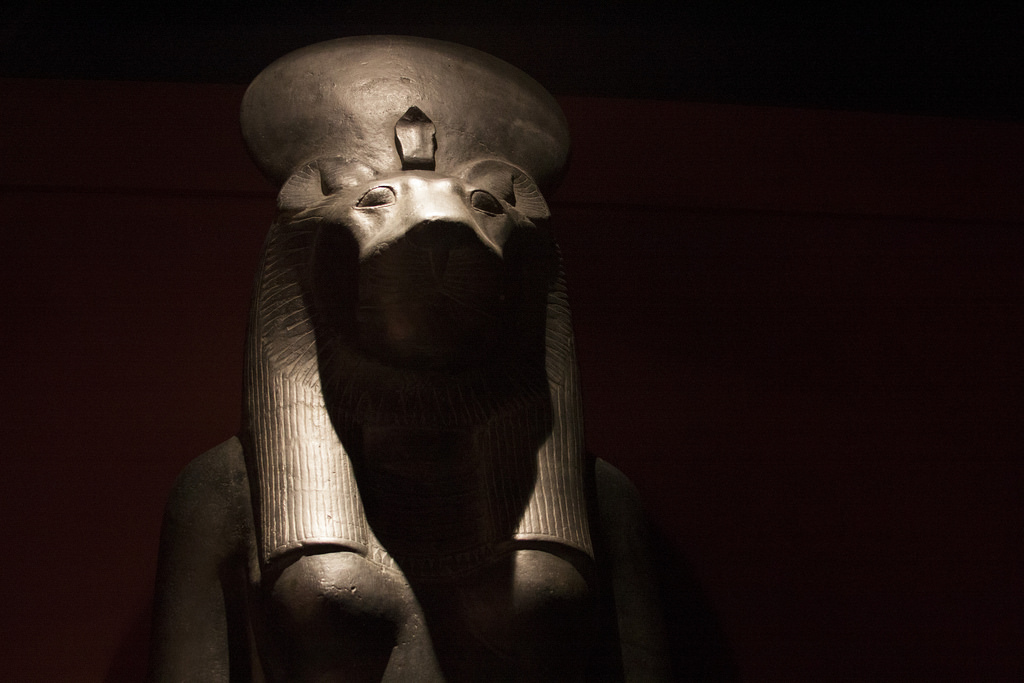
Chelle Fraser had a similar experience with the statue in San Jose: “I have, it brought me to my knees and I could just feel the heat coming off of it at the Rosicrucian museum in San Jose.”
Omma: “I am extremely privileged and honored to say that I have had an experience with a living statue of Sekhmet. I have not been to Egypt yet, but I have seen some of her statues in museums in the US and in the UK. It’s a good thing you’re not allowed to touch the statues, because I probably would have crawled into her lap and cried like a baby. I’m sure I still worried a few of the other museum patrons.”
VAMPIRES?
Sekhmet has attained a certain notoriety in the community of vampire enthusiasts due to the myth of her thirst for the blood of the unjust. Six of our respondents had never heard of the connection to the vampire community. Those who did had varying opinions.
Fannie Fae: “It’s my personal opinion that those who perpetuate that particular belief have fallen into the trap of an over simplification as to what Sekhmet‘s role is and really don’t understand Sekhmet very well. It makes for some very interesting modern mythos, but they are only dealing with a perceived role that She had and running with that when Sekhmet is a whole lot more. That vampire-version of her, if you will, has for good or for ill, become its own egregore. If folks who are into vampire culture want to worship Sekhmet, by all means, do. However, using Sekhmet as an “excuse” or as a justification for what they are doing – no. So, vampirism isn’t in the realm of my own, or any extant ancient practices.”
Gus Pinto: “Would it not depend on the nature of the relationship? As the defender of Ma’at, Sekhmet would be a destroyer of vampires rather than a mother-figure to them – but, having said that, since Sekhmet has control over plagues and destructive forces, a vampire or two in Her arsenal would not go amisss.”
Australia: “If they have a relationship with Sekhmet, that’s great. The other details, she can sort out just fine.”
1986: “Any contact with Sekhmet is better than none and I hope they will come out into the day and find the true power of Sekhmet.”
Amber: “I think they misunderstand, and of course it’s a little ironic to worship a sun goddess if daylight hurts you.”
Ginette Novello responded in greater detail:
“I see two major problems with Sekhmet as a vampire deity:
“1) Contrary to the legend of what vampires are, Sekhmet doesn’t need to drink blood in order to survive, nor does She demand blood offerings. For these reasons I would imagine that one of the Mesoamerican gods would be more appropriate as deity for vampires. In fact, in my religious tradition we’re told not to offer blood – either our own or from other sources – to Sekhmet because it caters to Her darker nature, although red beer is sometimes offered to Sekhmet as a substitute for blood in order to placate Her as it did in Her story of origin.
“Part of Sekhmet‘s teachings is to recognize and accept our darker or Shadow natures; the primary function of Shadow, after all, is to help us survive in dangerous and difficult situations. Sekhmet wouldn’t want us to be without a survival instinct by completely repressing or denying Shadow. However, we must also learn to control it, to not let Shadow consume us, to rise above it as She did: After Her great slaughter of humanity, She exiled Herself for a time and then went on to become the Enforcer of Ma’at as well as a healer and protector of the downtrodden. By choosing to worship only Her murderous, blood-drinking aspect is to deny Who She actually is: A goddess Who embodies a supreme lesson in temperance and self-control, Who learned from Her mistakes and went on to do good in the world, to help the humans She very nearly destroyed.
2) Sekhmet is a solar goddess, which seems in direct opposition to the image of the night-dwelling vampire.
“As a side-note, I’ve heard that some women feel that offering their menstrual blood to Sekhmet is appropriate, and I disagree with this concept as well. I realize that there are Pagan traditions in which menstrual blood is considered to be sacred, even magical, and I can respect that. However, I believe it is inappropriate to transfer this concept to the worship of an Egyptian deity because blood was considered to be a contaminating factor in a temple or otherwise sacred setting in Egypt. Priests who had open cuts or sores, or priestesses who were menstruating, were not allowed to serve in religious rites.
Traditions aside, from a physical and scientific point of view menstrual blood is essentially excrement: it is the dead, sloughed-off lining of the uterus that a woman’s body eliminates each month. I have a hard time getting past offering something like that to a deity; especially to Sekhmet, a goddess associated with Truth and Purity standards.”
CULTURAL APPROPRIATION AND ORTHODOXY
Seeing as how a strong community of Kemetic Revivalists are African American and among them are those who prefer to worship within their racial heritage, some look askance at white enthusiasts practicing their religion the question of Cultural Appropriation requires attention.

I turned to Ptahmassu Nosfra-Uaa for an answer. Ptahmassu is an artist who makes beautiful Kemetic icons. His life is devoted to his religious practice and he exemplifies the attention to detail of Orthordox Kemetic researchers. His work and practice are deeply informed by study of the original ancient Egyptian materials. See his “Sekhmet The Eye of Ra” painting here.
In a personal communication with us, he wrote: “The Gods are not humans, They are Gods, and They cannot be limited to race or culture; we’re the ones limited by those things. No person or race or culture can own the Gods. The Gods call Their people wherever They choose, and no one can gainsay the Gods when They call. My relationships with my Gods is not governed by my skin color, race, gender identification or sexual orientation. These are all subjective qualities that have nothing to do with the way in which my Gods interact with me. The true Gods move beyond race and gender, skin color, sexual orientation, etc.”
What about orthodoxy? Does it make sense to recreate as accurately as possible the traditional form of worship or is today’s eclectic approach that takes inspiration from various sources viable? Is one better than the other?
Ptahmassu was kind enough to allow us to quote excerpts from the in depth interview he did with Anna Applegate for Coming From the Heart.
“I think our ancient Ancestors were a lot more flexible than we are today in regards to cultural appropriation or adoption of gods from one pantheon into another. The ancient Mediterranean world especially became a hybrid of Egyptian-Hellenic, Hellenic-Roman, Egyptian-Hellenic-Roman culture and spirituality, beginning after the founding of Alexandria at the time of Alexander.”
“It’s something I think Pagans and Neopagans in general need to take more seriously, that these ancient goddesses and gods have their own identities and terms of manifestation that have existed intact for enormous spans of time, and they need to be honored, reverenced, and respected, not simply disregarded because these aren’t convenient or easy to approach from outside their original cultural context. I think we have to look at how long the Netjeru have maintained a dialogue with human beings through the language, prayers, texts, practices, and trappings of Kemetic culture. Far longer than America or the West has existed; and we’re coming along and saying, oh well, that was then, this is now, let’s do it another way.”
“But religion is an organic entity, it grows and develops and changes over time. This includes the Gods, Who are dynamic beings, fluid and ever changing, ever expanding. If we accept that the Netjeru are living gods, gods that still exist throughout creation, continuing creation, able and capable of demonstrating Their powers, then we must accept that They are not fixed in time and space, nor are They rooted to a single geographic location.”
“We have to acknowledge- if we acknowledge that our Gods still have something to offer to humankind in its present condition- that the Netjeru are reaching out to devotees in ways that devotees in the current era can understand and relate to personally. I do acknowledge these things, so I tend to be accepting of the fact that groups and individuals are connecting with the Netjeru outside the historically informed framework Kemeticism or Kemetic Reconstructionism provides.
“In these regards, we’re seeing Goddesses like Auset (Isis) and Sekhmet being provided with roles that fill a spiritual vacuum profoundly felt by women in many parts of the world. Are we really that surprised that Auset, Isis, is continuing Her travels through the known world, appearing here as a Goddess of women, and there as a source of ecstatic awakening or personal empowerment? Should it come as such a surprise that a Goddess like Sekhmet…a truly fierce Goddess, Who represented to the ancient Egyptians a source of both destruction and magical healing…should be associated with other dynamic Goddesses like Durga or Kali?…I’ve seen people’s lives radically changed by brushes with these Goddesses in contexts completely outside historically informed Kemeticism.”
“So, personally, my concerns regarding Goddesses like Sekhmet being adopted by groups and individuals outside a Kemetic context are a matter of intentions and respect. If you’re inviting Sekhmet to take part in your Circle or Coven, or you’re asking the Goddess for Her ability to awaken your latent Tantric power…if you’re using Her in conjunction with traditions and practices not historically associated with Her, then make sure your motivations and modes of operation are sincere, and include giving the Goddess the reverence and respect due to Her greatness.”
